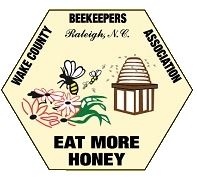 | Wake County Beekeepers Association |
Beekeeping Calendar
May
| The Bees |
Hives are very active, nectar and pollen should begin to come into the hive thick and fast. This is the peak of the egg laying season for the queen. The hive should be bursting with busy buzzing bees. Watch orientation flights regularly to gage population increases (lawn chair optional). Local nucs and Queens available. |
| The Beekeeper |
May and June are harvest months for our area. Inspect the hive weekly. Attend your bee club meetings and any workshops you can find. |
| Inspections |
Inspect the hive weekly. Have a plan before opening the hive. Record observations Mite checks for any that were not yet treated. Check supers, move less full frames in, fuller frames out |
| Queen health, laying |
Watch brood pattern (signs of queen productivity) Good queens will peak egg laying in April and May. Avoid honey bound condition, give her plenty of room to lay |
| Nutrition |
Poison Ivy (orange pollen) to 5/23; Tulip Poplar to 5/26; Offer syrup to new package bees to build comb as long as they continue to use it. Set up water stations. |
| Pests |
Monitor hive beetles Install small hive beetle traps. No pest treatments this month if you plan to harvest honey. |
| Management |
Keep adding supers, watch for overcrowding Continue swarm prevention measures Replace failing queens Make splits |
| Swarms |
Prime swarm months Watch for queen cells with larvae, dry cups will always be present and do not mean a swarm is pending. Ensure plenty of open brood cells to reduce swarm tendencies. Usually requires open brood COMB, as foundation frames take time to build and the colony doesn’t usually wait. |
| Products of the Hive |
Harvest in May, June and early July in a good year. Melt down wax from cappings and crushed comb and culled frames. |
Return to the Beekeeping Calendar
